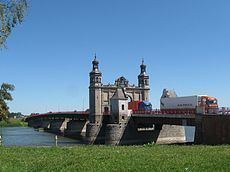Established After World War I | Length 227km | |
 | ||
The Lithuania–Russia border is an international border between the Kaliningrad Oblast, an exclave of the Russian Federation, and Lithuania. The 227 km long border passes (from west to south-east clockwise) through the Curonian Spit and Curonian Lagoon, and then follows along the Neman River, Šešupė, Širvinta, Liepona, Lake Vištytis. There is a tripoint between Lithuania, Russia and Poland with a stone monument at 54°21′48″N 22°47′31″E. Most of the border follows rivers or lakes. On land, border stations are equipped with engineering and technical facilities (wired fences and the exclusion zone). Most other land areas have no fence, but some places near roads or villages have fences (e.g. at 54°27′11″N 22°42′08″E with Street View coverage). Crossing the border into Lithuania requires a Schengen visa, and into Russia requires a Russian visa.
Contents
History
Historical borders between the Grand Duchy of Lithuania and Tsardom of Russia varied significantly throughout history, and at times bore little resemblance to the modern borders.
The modern Lithuanian-Russian border was established after World War I. For the most part it follows the border of former German province of East Prussia. In 1923, the Klaipėda Region (Memelland) was transferred to Lithuania, and in 1939, Lithuania was forced to return it to Germany. Until 1991, this boundary was an internal border of the Soviet Union between the RSFSR and the Lithuanian SSR. In 1997, the Russian Federation and the Republic of Lithuania signed a border agreement, which eliminated absurdities of the border. For example, Lake Vištytis was divided between the states as before almost the entire area of the reservoir was part of the Russian Federation. Therefore, fishers and swimmers on the Lithuanian side inadvertently crossed the international border. In return, Russia received the appropriate territorial compensation in other areas. The treaty entered into force in 2003.
Economy
At the Russian-Lithuanian border smuggling takes place and semi-legal "shuttle" trade cheaper Russian and Belarusian products, which are exported to Lithuania for resale. Especially popular are cigarettes.
